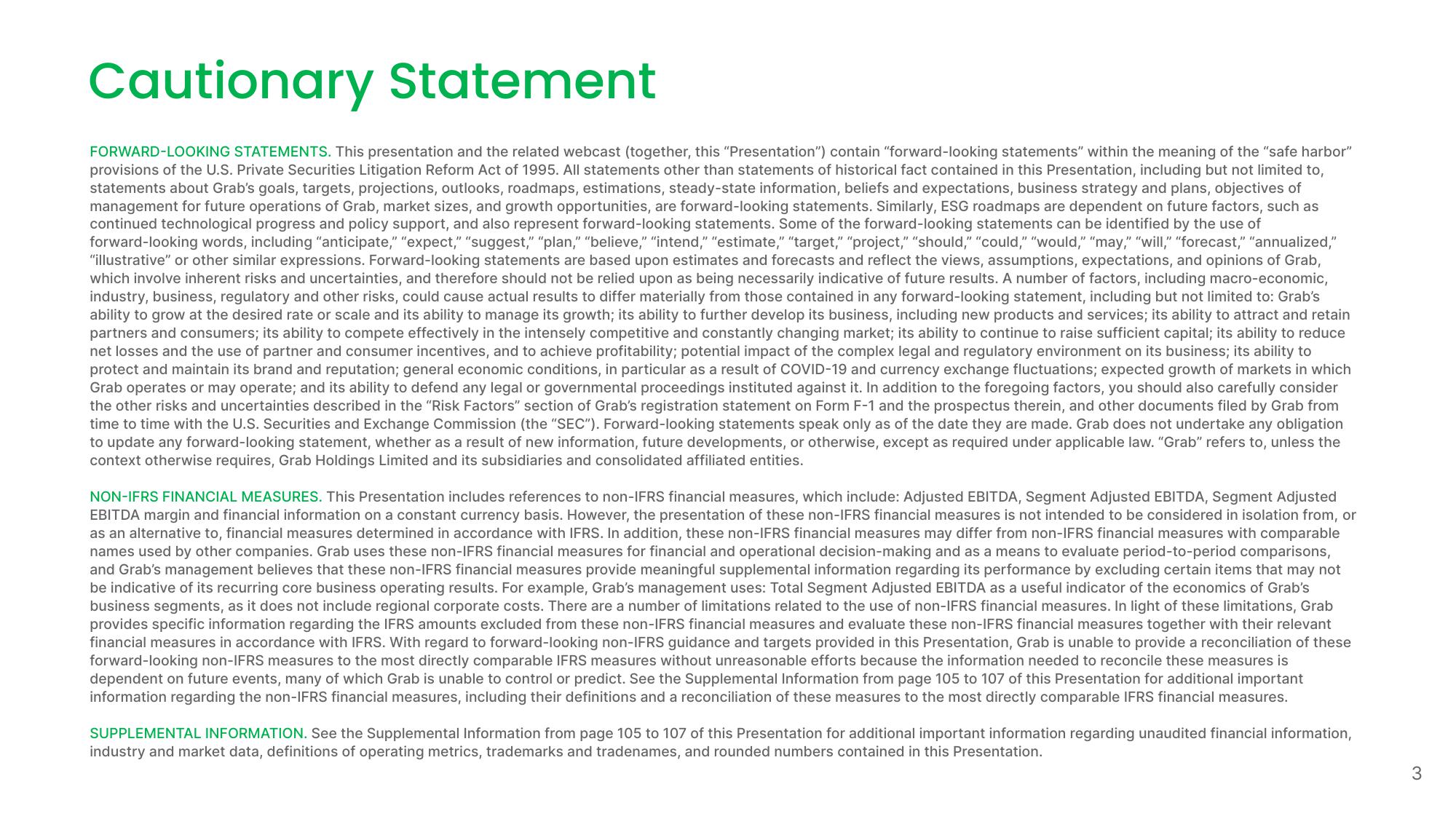Grab Investor Day Presentation Deck
Cautionary Statement
FORWARD-LOOKING STATEMENTS. This presentation and the related webcast (together, this "Presentation") contain "forward-looking statements" within the meaning of the "safe harbor"
provisions of the U.S. Private Securities Litigation Reform Act of 1995. All statements other than statements of historical fact contained in this Presentation, including but not limited to,
statements about Grab's goals, targets, projections, outlooks, roadmaps, estimations, steady-state information, beliefs and expectations, business strategy and plans, objectives of
management for future operations of Grab, market sizes, and growth opportunities, are forward-looking statements. Similarly, ESG roadmaps are dependent on future factors, such as
continued technological progress and policy support, and also represent forward-looking statements. Some of the forward-looking statements can be identified by the use of
forward-looking words, including "anticipate," "expect," "suggest," "plan," "believe," "intend," "estimate," "target," "project," "should," "could," "would," "may," "will," "forecast," "annualized,"
"illustrative" or other similar expressions. Forward-looking statements are based upon estimates and forecasts and reflect the views, assumptions, expectations, and opinions of Grab,
which involve inherent risks and uncertainties, and therefore should not be relied upon as being necessarily indicative of future results. A number of factors, including macro-economic,
industry, business, regulatory and other risks, could cause actual results to differ materially from those contained in any forward-looking statement, including but not limited to: Grab's
ability to grow at the desired rate or scale and its ability to manage its growth; its ability to further develop its business, including new products and services; its ability to attract and retain
partners and consumers; its ability to compete effectively in the intensely competitive and constantly changing market; its ability to continue to raise sufficient capital; its ability to reduce
net losses and the use of partner and consumer incentives, and to achieve profitability; potential impact of the complex legal and regulatory environment on its business; its ability to
protect and maintain its brand and reputation; general economic conditions, in particular as a result of COVID-19 and currency exchange fluctuations; expected growth of markets in which
Grab operates or may operate; and its ability to defend any legal or governmental proceedings instituted against it. In addition to the foregoing factors, you should also carefully consider
the other risks and uncertainties described in the "Risk Factors" section of Grab's registration statement on Form F-1 and the prospectus therein, and other documents filed by Grab from
time to time with the U.S. Securities and Exchange Commission (the "SEC"). Forward-looking statements speak only as of the date they are made. Grab does not undertake any obligation
to update any forward-looking statement, whether as a result of new information, future developments, or otherwise, except as required under applicable law. "Grab" refers to, unless the
context otherwise requires, Grab Holdings Limited and its subsidiaries and consolidated affiliated entities.
NON-IFRS FINANCIAL MEASURES. This Presentation includes references to non-IFRS financial measures, which include: Adjusted EBITDA, Segment Adjusted EBITDA, Segment Adjusted
EBITDA margin and financial information on a constant currency basis. However, the presentation of these non-IFRS financial measures is not intended to be considered in isolation from, or
as an alternative to, financial measures determined in accordance with IFRS. In addition, these non-IFRS financial measures may differ from non-IFRS financial measures with comparable
names used by other companies. Grab uses these non-IFRS financial measures for financial and operational decision-making and as a means to evaluate period-to-period comparisons,
and Grab's management believes that these non-IFRS financial measures provide meaningful supplemental information regarding its performance by excluding certain items that may not
be indicative of its recurring core business operating results. For example, Grab's management uses: Total Segment Adjusted EBITDA as a useful indicator of the economics of Grab's
business segments, as it does not include regional corporate costs. There are a number of limitations related to the use of non-IFRS financial measures. In light of these limitations, Grab
provides specific information regarding the IFRS amounts excluded from these non-IFRS financial measures and evaluate these non-IFRS financial measures together with their relevant
financial measures in accordance with IFRS. With regard to forward-looking non-IFRS guidance and targets provided in this Presentation, Grab is unable to provide a reconciliation of these
forward-looking non-IFRS measures to the most directly comparable IFRS measures without unreasonable efforts because the information needed to reconcile these measures is
dependent on future events, many of which Grab is unable to control or predict. See the Supplemental Information from page 105 to 107 of this Presentation for additional important
information regarding the non-IFRS financial measures, including their definitions and a reconciliation of these measures to the most directly comparable IFRS financial measures.
SUPPLEMENTAL INFORMATION. See the Supplemental Information from page 105 to 107 of this Presentation for additional important information regarding unaudited financial information,
industry and market data, definitions of operating metrics, trademarks and tradenames, and rounded numbers contained in this Presentation.
3View entire presentation